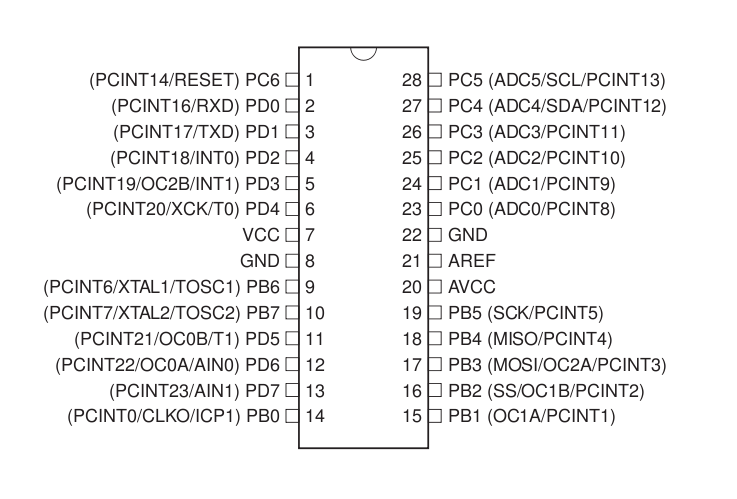AVR Microcontroller Class 2011: Difference between revisions
From HacDC Wiki
Hexagon5un (talk | contribs) |
Hexagon5un (talk | contribs) |
||
| Line 77: | Line 77: | ||
'''Demo Code''': [[Media: avr2011_externalInterrupt.tgz]] [[Media: avr2011_serialInterrupt.tgz]] | '''Demo Code''': [[Media: avr2011_externalInterrupt.tgz]] [[Media: avr2011_serialInterrupt.tgz]] | ||
'''Labs''': Bunch of pushbutton interrupt routines, light/dark transition sensor, non-blocking serial I/O | |||
''' | '''Homework''': Response-time-tester Game or "improved" interrupt-driven ghetto oscilloscope | ||
''' | '''Resources''': | ||
== Class 4: EEPROM, PROGMEM, ?, Profit. == | == Class 4: EEPROM, PROGMEM, ?, Profit. == | ||
Revision as of 20:29, 21 March 2011
Syllabus, course material, homeworks, photos, etc from an Introduction to Microcontrollers with AVR chips class can be found here.
Also see (and contribute to) Useful AVR Links Or check out the old version of the course AVR Microcontroller Class 2009
Class 0: Introduction and Setup
Hello World!
Covers: What the AVRs are, what all the pins do, what they can do for you. A brief tour of the toolchain, and getting your firmware up and running on the chip. Reading the datasheets. How to make chips speak digital to the outside world, pin-by-pin. Just enough C programming fundamentals to make it work.
Slides: Media:avr2011_class0.pdf
Lab: Building the kit and running a test LED flasher.
For assembly instructions and more details on the class kit, see Avr2011_kit. How to program the class kit, see Avr2011 Programming The Kit.
Demo Code: Media: LED_Demo.tgz
Homework: More soldering, and Cylon Eyes. Optional extra credit: Simple POV toy (hint, make the timing around 2ms between updates and swing your arms). Super bonus points: Make a neat POV toy.
OPC (Other People's Code):
Media: Pov demo.tar.gz An example POV toy. This contains 4 different patterns; two diamonds, a trapezoid and a smiley face. Also contains examples of using a character array to drive the POV toy, as well as use of constants to determine how the program runs. - Will
Resources:
- ATmega48P Datasheets (get both): ATmega48P Summary Datasheet and The Long ATmega48P Datasheet
- Bootloader appnote [1]
- Installing AVR Toolchain
Class 1: Digital and Serial I/O
Interfacing with the real world is the soul of microcontrolling.
Covers: Gathering simple data from the world, and learn how to spit it back out. A serial link with your computer enables all sorts of tricks, and enables the microcontroller version of printf debugging. Some boolean logic comes in handy here. Along the way, we'll learn a bunch about debouncing switches.
Slides: Media:avr2011_class1.pdf
Labs: More Cylon Eyes, All sorts of button-pressing demos, ASCII-to-binary keymapper, General-purpose serial LED display
Demo Code: Media: avr2011_class1_demoCode.tgz
HW: Ghetto logic probe and analyzer: read input on PORTC, display values on the LEDs, write out the value of PINC over serial, interpret/log/whatever using your laptop
OPC (Other People's Code): microTweeter a silly little program to interface twitter with a microcontroller. It is designed to post quotes from a file when a button is pressed on a microcontroller. This was done as learning experience with python, serial communications and social media integration. -Will G.
Resources:
- More than you ever wanted to know about debouncing: A Guide to Debouncing
Class 2: ADC and PWM: "Analog" I/O
Covers: Learn about ways to fake analog data into and out of your microcontroller. We'll learn how to switch logic states fast to emulate an analog output, and how to use the built-in analog-to-digital converters to measure the complex real-world.
Slides: Media:avr2011_class2.pdf
Demo Code: Media: avr2011_class2_demoCode.tgz
Labs: Dimming LEDs, light-level meter, ghetto oscilloscope
Homework: Auto-dimming LED or basic light-level data logger
Resources: You'll need to solder up the light sensors: [follow these directions]
Class 3: Interrupts
Covers: Interrupts call subroutines when certain conditions are true. They take a lot of the programming burden off your shoulders, enable the AVR to syncronize to external devices, and are great for super-fast response applications.
Slides: Media: avr2011_class3.pdf
Demo Code: Media: avr2011_externalInterrupt.tgz Media: avr2011_serialInterrupt.tgz
Labs: Bunch of pushbutton interrupt routines, light/dark transition sensor, non-blocking serial I/O
Homework: Response-time-tester Game or "improved" interrupt-driven ghetto oscilloscope
Resources:
Class 4: EEPROM, PROGMEM, ?, Profit.
Covers: PROGMEM lets you use the program memory to store lots of (constant) data. EEPROM is like flash -- there's not much of it, but it stays around when you power off. We'll also cover simple state machines and menu-driven interfaces here.
Labs: Arbitrary waveform generation by direct-digital synthesis, and a menu system to run it
Homework: Not sure yet...
Class 5: I2C, USB, SD Cards, GPS
Covers: Learning to use other people's code and tie it in to our packages. Interfacing with all sorts of random devices for fun and profit.
Labs: I'll be providing example code interfacing with all sorts of external gear. Pick and choose whichever you'd like to implement.
Homework: None. It's project time! Start thinking up what you'd like to do here...

